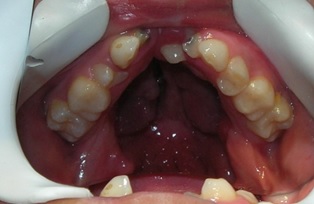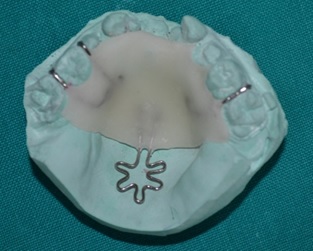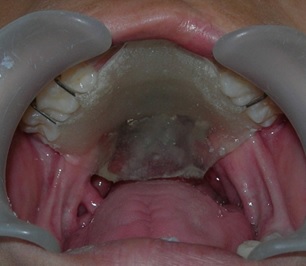The Soft Palate Friendly Speech Bulb for Velopharyngeal Insufficiency
Sukhdeep Singh Kahlon1, Monaliza Kahlon2, Shilpa Gupta3, Parvinder Singh Dhingra4
1 Professor and Head, Department of Orthodontics and Dentofacial Orthopedics, SGRD Institute of Dental Sciences and Research, Sri Amritsar, Punjab, India.
2 Medical Officer (Dental), Government Dental College, Sri Amritsar, Punjab, India.
3 Reader, Department of Orthodontics and Dentofacial Orthopedics, SGRD Institute of Dental Sciences and Research, Sri Amritsar, Punjab, India.
4 Postgraduate Student, Department of Orthodontics and Dentofacial Orthopedics, SGRD Institute of Dental Sciences and Research, Sri Amritsar, Punjab, India.
NAME, ADDRESS, E-MAIL ID OF THE CORRESPONDING AUTHOR: Dr. Sukhdeep Singh Kahlon, 234-Medical Enclave Circular Road, Sri Amritsar-143001, Punjab, India.
E-mail: singhkahlon@yahoo.com
Velopharyngeal insufficiency is an anatomic defect of the soft palate making palatopharyngeal sphincter incomplete. It is an important concern to address in patients with bilateral cleft lip and palate. Speech aid prosthesis or speech bulbs are best choice in cases where surgically repaired soft palate is too short to contact pharyngeal walls during function but these prosthesis have been associated with inadequate marginal closure, ulcerations and patient discomfort. Here is a case report of untreated bilateral cleft lip and palate associated with palatal insufficiency treated by means of palate friendly innovative speech bulb. This modified speech bulb is a combination of hard acrylic and soft lining material. The hard self-curing acrylic resin covers only the hard palate area and a permanent soft silicone lining material covering the soft palate area. A claw-shaped wire component was extended backwards from acrylic and was embedded in soft silicone to aid in retention and approximation of two materials. The advantage of adding the soft lining material in posterior area helped in covering the adequate superior extension and margins for maximal pharyngeal activity. This also improved the hypernasality, speech, comfort and overall patient acceptance.
Bilateral cleft lip and palate, Hypernasality, Velopharyngeal Sphincter
Case Report
Velopharyngeal insufficiency is an anatomic defect of the soft palate making palatopharyngeal sphincter incomplete. Conventional treatment with speech bulb fabricated with self curing resin or heat curing resin have been associated with inadequate marginal adaptation, soft palate discomfort and ulcerations. The case report of a 14 year old patient with palatal insufficiency due to unrepaired Bilateral Cleft Lip and Palate (BCLP), rehabilitated by a new modified palate-friendly speech bulb is presented.
Chief Complaint: A 14 year old male patient presented with a chief complaint of difficulty in speech and swallowing with a nasal twang and presence of large unrepaired bilateral cleft palate. On examination, the patient had an unrepaired wide bilateral cleft palate involving complete hard and soft palate. Speech was affected with hypernasality. On intraoral examination, patient had palatally placed left maxillary central incisor, grossly carious left and right maxillary lateral incisor and missing right maxillary central incisor [Table/Fig-1].
Patient’s intraoral examination.

A diagnosis of unrepaired bilateral cleft of hard and soft palate with hypernasal speech was established.
Treatment Plan: The grossly carious maxillary left and right lateral incisors were planned for extraction. Thorough oral prophylaxis was carried out. Keeping in view the hypernasal speech and the deficient soft palate, a speech bulb was planned. In order to counter the side-effects of ulceration and soft palate irritation as reported with the conventional speech bulb, a modification of speech bulb appliance was planned for the patient restricting self curing resin till the hard palate, while in region of soft palate, permanent soft silicone lining material (GC Corporation, Tokyo, Japan) was used to make this appliance more palate friendly.
Procedure
The alginate impression of maxillary arch was taken.
Dental cast was fabricated using dental stone.
A special tray was fabricated using self cure acrylic and was extended in pharyngeal area.
Tray was trimmed on pharyngeal area to avoid any rough edges after checking it in patient’s mouth.
Borders were molded in pharyngeal area using green stick impression compound and secondary impression was taken with rubber base impression material.
Another cast was poured in dental stone.
Retentive components of removable appliance were fabricated on molars in the form of pin-head clasps and a conventional removable appliance was fabricated using clear cold cure resin extending till hard palate [Table/Fig-2].
A claw shaped wire component was made with 0.7mm stainless steel wire and contoured to posterior pharyngeal area. This was partially embedded in the cured hard acrylic. The remaining posterior area was fabricated using soft silicon lining material (GC Corporation, Tokyo, Japan) [Table/Fig-3].
The appliance was then delivered to the patient with necessary chair side adjustments [Table/Fig-4].
Laboratory fabrication of retentive components and cold cure acrylic plate in hard palate area.

Completed appliance with cold cure acrylic in hard palate region and soft reliner in soft palate region.

Patient with the appliance in place.

Discussion
Palatopharyngeal insufficiency is an acquired or congenital anatomic defect of the soft palate that makes the palatopharyngeal sphincter incomplete [1]. This could lead to eating, breathing and speech problems. There are four broad etiologic categories: anatomic deficiency, myo-neural deficiency, anatomic and myo-neural deficiency and neither anatomical nor myo-neural deficiency [2]. The palatopharyngeal defects can be classified according to the degree and type of palatopharyngeal closure. Palatopharyngeal incompetence is when there is adequate soft palatal tissue but it lacks proper movement and on the other hand palaopharyngeal insufficiency is when there is lack of palatal tissue [3]. It can be corrected by surgical approach or prosthodontic appliances. Speech prosthesis or speech bulb is best choice in case when surgically repaired soft palate is too short to contact pharyngeal walls during function [4]. Soft palate obturators are more effective in velopharyngeal insufficiency when there is inadequate tissue [5].
Velopharyngeal (VP) sphincter is a three dimensional muscular wall formed by soft palate, lateral and posterior pharyngeal wall. For proper functioning of swallowing and speech adequate VP closure is required. Lack of soft tissue in the VP sphincter will lead to VP insufficiency [6]. The soft reliner material used in the new improved appliance closely approximated the pharyngeal tissue and thus, compensated for the velopharyngeal insufficiency, by creating a seal between oral and nasal cavity along with added advantage of reduced discomfort and better compliance. Obturator prosthesis attempts to re-establish velopharyngeal closure, control nasal emission during speech and assist in preventing nasal regurgitation of food and fluids during swallowing [7]. In this case, acrylization of the appliance is done with the help of self curing acrylic resin till the hard palate, while in region behind hard palate, speech bulb [obturator] is fabricated with permanent soft silicone lining material (GC Corporation, Tokyo, Japan). The material is soft and flexible, which permits the surrounding tissue movements and helps in closure of VP sphincter. The material being soft in posterior areas does not lead to frequent ulcerations as is common with conventional speech bulb appliances. Patient showed high level of co-operation with this modification.
The only major concern in using the material was its retention and approximation with the acrylic, which was eliminated by means of claw shaped wire component. Thus, this appliance was suited for intervention of VP insufficiency in untreated cases of cleft palate.
Conclusion
Patient reported more comfort and acceptance by using this appliance as compared to conventional speech bulb with added advantage of palate friendly soft reliner. Appliance was stable during both nourishment and speech. The patient reported improvement in quality of life with reduced complaints of ulceration and discomfort. Reduced hypernasality and improved speech was reported as compared to conventional appliance.
[1]. Dandekeri S, Sowmya MK, Bhandary S, A maxillofacial rehabilitation with velopharyngeal obturator prosthesis: A case reportInt J Biomed Res 2012 3(06):285-87. [Google Scholar]
[2]. Marsh JL, Management of velopharyngeal dysfunction: differential diagnosis for differential managementJ Craniofac Surg 2003 14(5):621-28. [Google Scholar]
[3]. Uphadhyay M, Jain D, Kumar S, Uppal S, Speech aid prosthesisBMJ Case Rep 2013 2013:bcr2013010102 [Google Scholar]
[4]. Pinto JHN, Dalben GS, Pegoraro-Krook MI, Speech Intelligibility of patients with cleft lip and palate after placement of speech prosthesisThe Cleft Palate-Craniofacial Journal 2007 44(6):635-41. [Google Scholar]
[5]. Woo AS, Velopharyngeal dysfunctionSemin Plast Surg 2012 26(4):170-77. [Google Scholar]
[6]. Tuna SH, Pekkan G, Gumus HO, Aktas A, Prosthetic rehabilitation of velopharyngeal insufficiency: pharyngeal obturator prostheses with different retention mechanismsEur J Dent 2010 4(1):81-87. [Google Scholar]
[7]. Akin H, Coskun ME, Akin EG, Ozdemir AK, Multidisciplinary approach for esthetic, functional, and quality-of-life outcome in soft palate cleft patientThe Cleft Palate-Craniofacial Journal 2012 49(5):622-25. [Google Scholar]